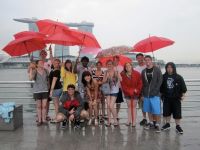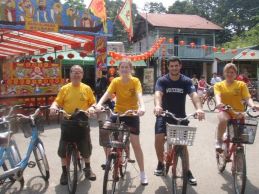One of our students pointed out that the Singapore we’ve seen is a city designed for tourism. I had to counter that we arrived here on a late Friday and we were leaving early Monday morning; hence, what we would see were primarily tourist sites—and the tourists, whom Singapore, knowing tourism is the world’s largest business, has consciously (everything in Singapore is conscious) sought to attract. In recent years, the government has tried to shed the “boring” impression of Singapore as a “fine” city,  where you get fined for spitting, chewing gum, etc., and built a number of facilities to attract foreigners. For example, gambling is legal; in good Singapore fashion, locals pay $100 Singapore to enter. The city fathers don’t want their own citizens addicted.
where you get fined for spitting, chewing gum, etc., and built a number of facilities to attract foreigners. For example, gambling is legal; in good Singapore fashion, locals pay $100 Singapore to enter. The city fathers don’t want their own citizens addicted.
Singapore is home to many multinationals because it is a well-run city. In the past, we’ve visited the American Embassy, Caterpillar (which has a logistics facility here), Medtronic, and Cargill. It’s a regional hub for Cargill, we were told, because it’s close to anywhere in Asia, and it’s a civilized place to live. I saw two things that demonstrated good Confucian values, if not civility. On the bus, seats are reserved for the elderly, handicapped, and pregnant women. The driver stopped when a pregnant woman got on and scolded a man to put his daughter on his lap to free the seat for the woman so he could continue to drive. On the subway, three people shooed others away and insisted a foreign professor take the seat for the old guys. I accepted with some embarrassment, preferring to think it was respect for teachers rather than for age!
When we crossed the border from Malaysia, it was readily apparent. Housing developments and high rises, which accommodate nearly 90% of the 5.3 million Singaporeans, are incredibly clean. We were told they get fresh paint every five years, which helps prevent the heat/humidity/salt damage we’ve seen in so many other Asian cities. And, given that Singapore has nothing but human capital (it imports food and water, among other things), the Singapore story (the title of founding father Lee Kwan-yew’s biography) is indeed impressive. The government (it’s been one-party rule since it separated from Malaya in the mid ’60s) has focused on education, jobs, and housing—with the result that the standard of living is I believe higher than England.
We had a free day today, and I convinced three of our students to fulfill one of my bucket list goals—to bike on Pulau Ubin. The island, off Singapore,  which is itself an island in charge of 60-some islands, is a jungle that supposedly resembles Singapore 50 years ago (I can only imagine what it was like before the opening of the Suez Canal in the 1860s put it on the map); it had been a British colony since 1819, when Raffles got the local Sultan to cede it to the British—the lion supposedly seen by the Indonesian ruler gave the area its name, Singha(lion) pura. We took the subway to the bus to Changi Village where we caught a boat to bike for about 3 hours in Singapore circa 1950; it was thick with trees, some wild animals (a boar burst from the woods), some Malay and Chinese homes and cemeteries, and a few new resorts. Most of the trails were paved, at least the 10 miles or so we traversed, but we did get off to walk along the ocean and through a mangrove swamp (with mangrove palms)—typically education plus!
which is itself an island in charge of 60-some islands, is a jungle that supposedly resembles Singapore 50 years ago (I can only imagine what it was like before the opening of the Suez Canal in the 1860s put it on the map); it had been a British colony since 1819, when Raffles got the local Sultan to cede it to the British—the lion supposedly seen by the Indonesian ruler gave the area its name, Singha(lion) pura. We took the subway to the bus to Changi Village where we caught a boat to bike for about 3 hours in Singapore circa 1950; it was thick with trees, some wild animals (a boar burst from the woods), some Malay and Chinese homes and cemeteries, and a few new resorts. Most of the trails were paved, at least the 10 miles or so we traversed, but we did get off to walk along the ocean and through a mangrove swamp (with mangrove palms)—typically education plus!
Yesterday we saw tourist spots and tourists (few get to Pulau Ubin) that typify the shopping, eating, and sightseeing. Places included the Orchid M useum (did you know that 10% of all flowers are orchids?), the colonial quarter (Little India, Chinatown, and the British buildings that now house government offices); the financial district (services and technology is how Singapore is trying to maintain its role as a supplier of human capital). It has the busiest container port, which I think is one of the most stunning sights in the city. Some 130 banks call it home; 11 are local/global powers, the Sands casino, and harbor, and the primarily resort island of Sentosa.
useum (did you know that 10% of all flowers are orchids?), the colonial quarter (Little India, Chinatown, and the British buildings that now house government offices); the financial district (services and technology is how Singapore is trying to maintain its role as a supplier of human capital). It has the busiest container port, which I think is one of the most stunning sights in the city. Some 130 banks call it home; 11 are local/global powers, the Sands casino, and harbor, and the primarily resort island of Sentosa.
I’ve been to the aquarium, so I separated off to the lone remaining fort on the island, which is part of Singapore’s World War II story—an important one, it turns out in the global picture. Churchill called the fall of Singapore the greatest disaster of the war, and in terms of the East/West balance, it was as important afterwards as the Japanese victory over Russia had been in 1905—proof that the West was not superior and could not protect its colonies. In Singapore’s case, its vulnerability by air (two battleships sent to protect the peninsula were sunk on December 10, 1941; the Japanese had 3 times the number of planes, and they were superior), and the quick advances down the peninsula (the Japanese were in Johore, across from Singapore by early February) overcame the fact that the British had over twice as many soldiers as the Japanese did. The Commander, Gen. Percival, wanted to fight on, but his staff argued for surrender; the terms were unconditional surrender.
On the way back from biking today, I realized we were passing a museum I’d not yet seen, one that would complete for me the WWII story—the prison at Changi was where the Japanese interned the Allied soldiers (Indian troops were the majority; then Brits, Australians, New Zealanders, and some  Americans and Dutch). The Japanese occupation of Syanon–their name for the city– was, like most WWII prisons, horrendous. Angered by support for the Chinese in China, the Japanese murdered around 6,000 (though estimates range up to 20,000), taking boatloads out and shoving them overboard. Many westerners (the Japanese generally held people who surrendered in contempt) got taken to build the famous (or infamous) railroad from Burma to Thailand that you may know from the Bridge over the River Kwai.
Americans and Dutch). The Japanese occupation of Syanon–their name for the city– was, like most WWII prisons, horrendous. Angered by support for the Chinese in China, the Japanese murdered around 6,000 (though estimates range up to 20,000), taking boatloads out and shoving them overboard. Many westerners (the Japanese generally held people who surrendered in contempt) got taken to build the famous (or infamous) railroad from Burma to Thailand that you may know from the Bridge over the River Kwai.
This is an historic time politically for the ruling People’s Action Party. In the election last week, Singaporeans voted for the opposition parties in record number. Six (of the 84) seats in Parliament went to the opposition, the most in Singapore’s history; the popular support fell to 60%, down 15% from ten years ago, and about nine percent from five years ago. This vote, despite Mentor Minister Lee’s urging, “Don’t rock this foundation. Remember, don’t risk your assets, property values, job opportunities.” Even more baldly, voters ignored Lee II (his son is prime minister), who warned that PAP favors PAP districts for improvements in housing. The papers attribute the vote to more open information partly via the internet, more well-educated opposition, and concerns about immigration which has led to housing and transportation pressures (about 2 million foreigners work in Singapore; if you have a skill, it’s relatively easy to get a work permit). In any case, the 87-year-old Minister Mentor and his immediate successor have announced their resignation in this morning’s newspaper. No doubt the Singapore story, notwithstanding the title of Lee’s biography, will have different chapters in the future.
We’re leaving for the airport at 4:30 am, so I’ll close now, but I’ll give you one more good reason to visit Singapore—near the equator (we’re 1 degree 18 minutes north) and close to sea level, gravity exerts an extra pull, which is why your scale lies here!
Maybe it’s true in Ho Chi Minh city, which used to be called Saigon, our next stop.